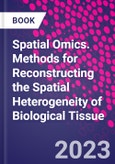Spatial Omics: Methods for Reconstructing the Spatial Heterogeneity of Biological Tissue is a complete and detailed reference on research methods that combine the in-depth analysis at single cell level with context provided by tissue positioning. The methods covered in the book include Methods that require the mechanical tissue retrieval, digestion and enrichment, Methods based on in situ hybridization and imaging, Methods reliant on next generation sequencing and hybrid techniques, and Computational based methods to determine spatial relatedness of cells. Technologies are focused on the balance between sensitivity, accuracy, and extent of features through which single cells can be evaluated, and more.
Cellular and molecular biologists will benefit from the detailed experimental setup information included in this comprehensive book. Computational biologists and computer scientists involved in biological visualization problems can also use this book as a guide to interpret and analyze experimental data.
Table of Contents
Introduction 1. Comment on Spatial Transcriptomics Landscape 2. Comment on Human Cell Atlas and CZI Initiatives Targeted dissection coupled with gene expression 3. Manual dissection, digestion and enrichment followed by NGS 4. General comment introduction to cell targeted NGS 5. Laser capture microdissection (LCM-SEQ) 6. Laser capture microdissection with (geo-seq) 7. Serial cryo-sectioning TOMO-SEQ 8. In-vivo transcriptome assessment (TIVA)
In-situ hybridization and imaging-based approaches 9. Single-Molecule RNA fluorescence in situ hybridisation (smFISH) 10. Multiplexed Error-Robust hybridisation technology (merFISH) 11. Sequential Fluorescence In-Situ Hybridisation (seqFISH/seqFish+) 12. Ouroboros smFISH (osmFISH) 13. RNAscope (RNAscope) RNAscope Hiplex 14. Fluorescent in situ RNA sequencing 15. In situ transcriptome accessibility sequencing (INSTAseq) and Barcode in situ Sequencing (BaristaSeq)
In situ mRNA capture and next generation sequencing 16. Slide-Seq 17. High-definition spatial transcriptomics 18. Nanostring digital spatial profiling 19. APEX-Seq 20. Microfluidic barcoding 21. Targeted cell isolation and profiling (Probe-Seq)
Emerging multimodal spatial imaging 22. DNA microscopy New class of imaging. Amazing. 23. Mass-cytometry coupled to multimodal analysis
In-silico tools for spatial transcriptomics 24. SpaceTx and Starfish (amalgamation of imaging-based approaches) 25. Oligonucleotide-based spatial barcoding followed with NGS. Hierarchical Barcoding 26. Incorporation of labelling approaches and multi-omics 27. Incorporation of histological data/tissue atlas generation 28. Downstream analyses incorporating lineage multi-modal data incorporation








